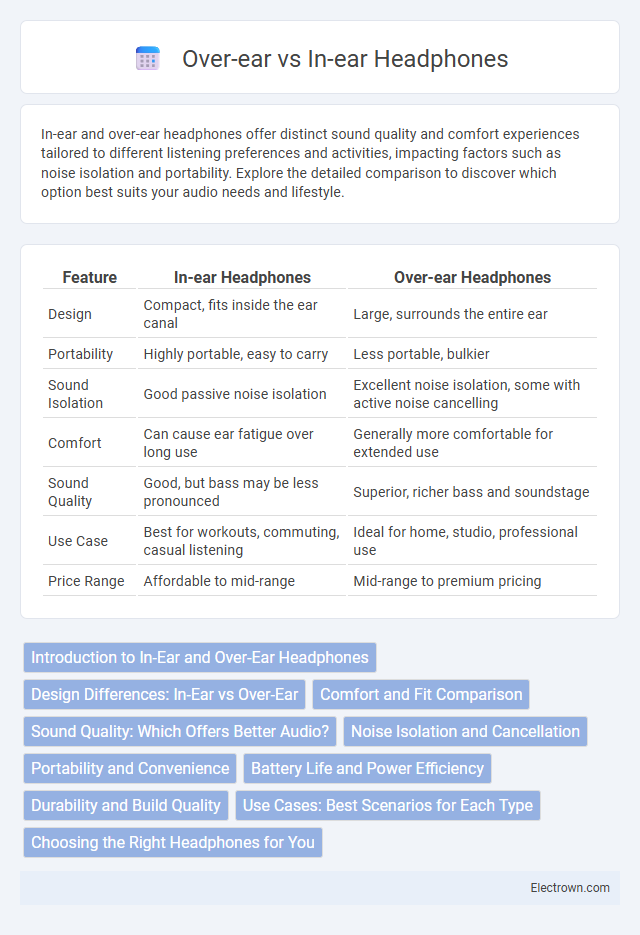In-ear and over-ear headphones offer distinct sound quality and comfort experiences tailored to different listening preferences and activities, impacting factors such as noise isolation and portability. Explore the detailed comparison to discover which option best suits your audio needs and lifestyle.
Table of Comparison
| Feature | In-ear Headphones | Over-ear Headphones |
|---|---|---|
| Design | Compact, fits inside the ear canal | Large, surrounds the entire ear |
| Portability | Highly portable, easy to carry | Less portable, bulkier |
| Sound Isolation | Good passive noise isolation | Excellent noise isolation, some with active noise cancelling |
| Comfort | Can cause ear fatigue over long use | Generally more comfortable for extended use |
| Sound Quality | Good, but bass may be less pronounced | Superior, richer bass and soundstage |
| Use Case | Best for workouts, commuting, casual listening | Ideal for home, studio, professional use |
| Price Range | Affordable to mid-range | Mid-range to premium pricing |
Introduction to In-Ear and Over-Ear Headphones
In-ear headphones provide a compact design that fits directly inside your ear canal, offering excellent noise isolation and portability, making them ideal for on-the-go use. Over-ear headphones feature large ear cups that encompass your ears fully, delivering superior sound quality, immersive audio experience, and enhanced comfort for extended listening sessions. Choosing between in-ear and over-ear headphones depends on your lifestyle, sound preferences, and usage scenarios.
Design Differences: In-Ear vs Over-Ear
In-ear headphones feature a compact design that fits snugly inside your ear canal, offering portability and effective noise isolation ideal for active use. Over-ear headphones have large ear cups that envelop your ears, providing superior comfort, immersive sound quality, and extended wearability. Your choice depends on whether you prioritize mobility and discreetness or enhanced audio performance and cushioning.
Comfort and Fit Comparison
In-ear headphones provide a lightweight, portable fit with silicone or foam tips that conform to the ear canal, offering noise isolation but sometimes causing discomfort during extended use. Over-ear headphones feature cushioned ear cups that encircle the ears, distributing pressure evenly and providing superior comfort for long listening sessions. Users sensitive to heat or ear fatigue often prefer over-ear models for their breathable design and adjustable headbands, whereas in-ear models excel in active or on-the-go scenarios due to their compact form factor.
Sound Quality: Which Offers Better Audio?
Over-ear headphones generally provide superior sound quality due to larger driver units that deliver richer bass, clearer mids, and more immersive highs with better soundstage and spatial accuracy. In-ear headphones, while compact and portable, often face limitations in driver size, resulting in less dynamic range and reduced depth in audio reproduction. However, premium in-ear monitors with balanced armature drivers can approach the sound fidelity of over-ear models, especially for detailed sound in professional audio applications.
Noise Isolation and Cancellation
In-ear headphones provide effective noise isolation by physically sealing the ear canal, blocking out ambient sounds without requiring power. Over-ear headphones often feature active noise cancellation (ANC) technology, using built-in microphones to detect and counteract external noise, offering a more immersive listening experience. Your choice depends on whether you prioritize passive noise isolation with a compact design or advanced ANC for superior sound suppression.
Portability and Convenience
In-ear headphones offer superior portability with their compact size and lightweight design, making them ideal for on-the-go use and easy storage in pockets or small bags. Over-ear headphones, while bulkier and less convenient to carry, provide enhanced comfort for extended listening sessions and better noise isolation. Your choice depends on whether you prioritize easy transportability or immersive audio experience.
Battery Life and Power Efficiency
Over-ear headphones generally offer longer battery life compared to in-ear models due to larger batteries housed within their ear cups, enabling extended playback times often exceeding 20 hours. In-ear headphones prioritize portability and lightweight design, resulting in smaller batteries that typically provide 4 to 8 hours of use per charge. Power efficiency varies with features such as active noise cancellation and Bluetooth versions, where over-ear headphones often integrate more advanced power management systems to balance high-quality audio performance and battery endurance.
Durability and Build Quality
Over-ear headphones typically offer superior durability and build quality due to robust materials like metal frames and reinforced ear cups designed for extended use. In-ear headphones, while more compact, often use lightweight plastic and rubber components that can be prone to wear and tear from frequent insertion and removal. High-end models in both categories incorporate premium materials such as braided cables and water-resistant coatings to enhance longevity.
Use Cases: Best Scenarios for Each Type
In-ear headphones excel in portability and discreet use, making them ideal for workouts, commuting, and travel due to their lightweight design and noise isolation capabilities. Over-ear headphones provide superior sound quality and comfort for extended listening sessions, making them perfect for studio monitoring, gaming, and home entertainment. The choice between in-ear and over-ear depends on the balance between mobility and immersive audio experience required in different scenarios.
Choosing the Right Headphones for You
In-ear headphones offer portability and noise isolation ideal for active lifestyles, while over-ear headphones provide superior sound quality and comfort for extended listening sessions. Your choice depends on usage scenarios, with in-ear models suited for commuting and workouts, and over-ear variants preferred for home or studio environments. Consider factors such as sound detail, comfort, and noise cancellation features to select the right headphones for your needs.
In-ear vs Over-ear Headphones Infographic

 electrown.com
electrown.com